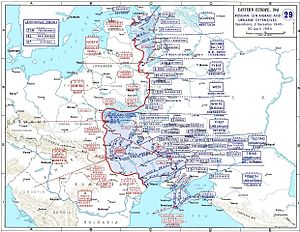Dnieper-Carpathian Offensive
| Dnieper–Carpathian Offensive | |||||||
|---|---|---|---|---|---|---|---|
| Part of the Eastern Front of World War II | |||||||
 Soviet advances during the operation |
|||||||
|
|||||||
| Belligerents | |||||||
|
|
|
||||||
| Commanders and leaders | |||||||
|
|
|
||||||
| Strength | |||||||
|
24 December: 2,406,100 men 2,015 tanks and assault guns 28,654 guns and mortars 2,600 combat aircraft |
Unknown | ||||||
| Casualties and losses | |||||||
|
1,192,000 men
7,532 guns and mortars lost 676 aircraft destroyed |
|
||||||
1,192,000 men
The Dnieper–Carpathian Offensive, also known in Soviet historical sources as the liberation of right-bank Ukraine, fought from 24 December 1943 – 17 April 1944, was a strategic offensive executed by the 1st, 2nd, 3rd, and 4th Ukrainian Fronts, along with the 1st Belorussian Front, against the German Army Group South, intended to retake all of the Ukrainian and Moldovian territories occupied by Axis forces. The operation brought the Red Army forces into Poland and Romania, completely destroyed 18 Wehrmacht and Romanian divisions, and reduced another 68 to below half of their establishment strength.
As part of the Lower Dnieper Offensive in autumn 1943, which secured the Left-bank, or eastern Ukraine and cut off the German 17th Army in the Crimea, several Soviet bridgeheads were established across the Dnieper River, which were then expanded throughout November and December to become the platforms from which the Dnieper—Carpathian Offensive was launched. This offensive and its follow-ups, which continued into December, left several large German salients along the Dnieper, including one south of Kiev centered on the city of Korsun, between the areas of the 1st and 2nd Ukrainian Fronts, and another to the south, around Kryvyi Rih and Nikopol. Adolf Hitler's "No retreat" policy forced German troops to hold the tenuous positions, despite opposition from Erich von Manstein, commander of Army Group South.
...
Wikipedia
